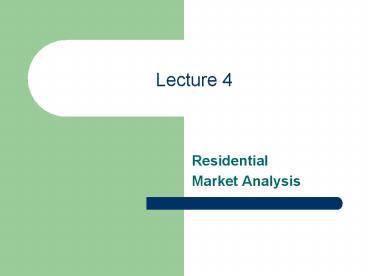Residential PowerPoint PPT Presentation
1 / 22
Title: Residential
1
Lecture 4
- Residential
- Market Analysis
2
Types of Residential Units
- Single-Family Detached
- Single-Family Attached
- Multifamily Housing
- Manufactured Housing
- Mobile Homes
3
Facts of Residential Real Estate Markets
- Residential structures account for about 24 of
the value of all assets owned in the United
States (value approximately 6 Trillion) - Neighborhood stability often presumed in areas
where a high proportion of housing units are
owned - Average square footage of homes in the U.S. has
increased nearly 25 in the last 50 years to
approximately 2,200 sf. - Approximately 68 of Americans own their home.
This percentage has increased from 64 in 1993.
4
Long-Term Demand for Housing
- Function of
- Number of households
- Household growth rate
- General economic productivity of income of the
typical household
5
Long-Term Demand for Housing
6
Long-Term Demand for Housing
- People living longer
- People having fewer children, decreasing
household size - Divorce rate increase
7
Regional Demand for Housing
- Three factors leading to absolute and relative
growth in the number of households - Size of the existing population provides momentum
to the level of absolute population growth - Job growth correlates to the growth in the number
of households - Overall quality of life and cost of living in a
region
8
Short-Term Demand for Housing
- Two Dominant Factors
- Seasonality
- Mortgage interest rates
9
Seasonality Residential Home Sales
Average Monthly Sales
Springtime housing sales tend to run 40 higher
than in December
120
100
80
60
Jan
Feb
Mar
Apr
May
Jun
Jul
Aug
Sep
Oct
Nov
Dec
10
Short-Term Housing DemandMortgage Interest Rates
- Rather than buying a cheaper house as rates rise,
many buyers choose to wait and hope rates
decrease - When interest rates are decreasing, many
potential buyers wait in hopes that rates
continue to decrease, then will purchase when
rates increase in fear of continued rate
increases.
11
Lecture 4
- Buying Versus Renting
12
Renting Versus BuyingInitial Misconceptions
- Not enough capital to purchase
- Overabundance of square footage
- Property maintenance and costs
13
Economic Factors Affecting the Buy/Rent Decision
- Capital Constraints
- Expected Tenure
- Income Tax Rate
- Mortgage Rate Expectations
14
Economic Factors Affecting the Buy/Rent Decision
- Investment Aspects of Homeownership
- Budgeting Risk
- Psychological Factors
15
Lecture 4
- Government Regulation and Housing Demand
16
Federal Government Regulation
- Fair Housing Act
- Redlining
- Community Reinvestment Act
- FIRREA
- RESPA
17
Lecture 4
- Senior Housing
18
Senior Housing
- By 2050, the 85 and older population will have
increased 300 from year 2000. - 1 in 5 Americans in year 2030 will be 65 or older
- Senior segment of the economy outspends young
segment - Senior income increased by Social Security and
Medicare, etc.
19
Senior Housing
- Housing Desires of Seniors
- To locate near friends, relatives, doctors,
hospitals - To locate in safe areas
- To locate near shopping and entertainment
- To have privacy, and options for socializing
20
Senior Housing
- Housing Options for Seniors
- Active adult community independent living
facility housing - Congregate housing with assistance
- Congregate housing with assistance and nursing
- Skilled nursing homes
- Alzheimers specialized care centers
- Hospice centers
21
Lecture 4
- Future Housing Trends
22
Future Housing Trends
- More workers required to travel, paired with low
interest rates, creates a demand for second homes - Decrease in brokerage costs from the internet
- Fast growing market segments Seniors and
households with no children - Permanent tenants evolving from changes in
upscale rental units

